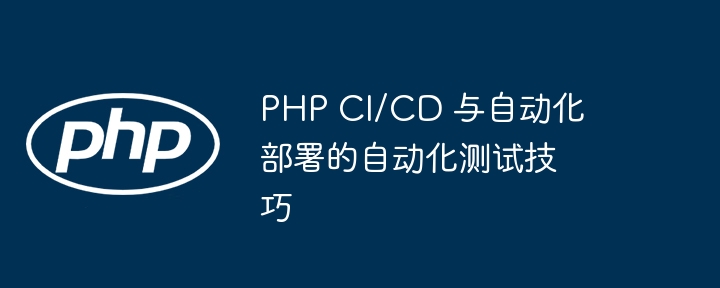 Backend Development
Backend Development
 PHP Tutorial
PHP Tutorial
 Automated testing skills for PHP CI/CD and automated deployment
Automated testing skills for PHP CI/CD and automated deployment
Automated testing skills for PHP CI/CD and automated deployment
Automated testing is crucial for PHP CI/CD and can be achieved through the following tips: Writing test cases using PHP unit tests and PHPUnit. Integrate PHPUnit test cases into CI/CD pipeline. Configure automatic deployment to automatically deploy code after tests pass.

Automated testing tips for PHP CI/CD and automated deployment
When adopting a CI/CD (continuous integration and continuous delivery) pipeline, automated testing is very important for Ensuring code quality and speeding up the deployment process are critical. This article will introduce how to use PHP unit testing and the PHPUnit framework to implement automated testing, and provide a practical case to show how to integrate it into the CI/CD process.
Introduction to PHP unit testing
PHP unit testing is a technique for testing a single PHP function, class, or method in an isolated environment. It verifies the correctness of code by checking whether specific inputs produce the expected output.
Write automated tests using PHPUnit
PHPUnit is a widely used PHP unit testing framework, which provides a rich set of assertion functions and testing tools to write and execute tests. The following is a sample PHPUnit test case:
use PHPUnit\Framework\TestCase;
class MyTestClass extends TestCase
{
public function testExample()
{
$expected = 'foo';
$actual = 'foo';
$this->assertEquals($expected, $actual);
}
}In the above example, the testExample method is a test function that uses the assertEquals assertion to verify expected and actual variables are equal.
Practical Case: Integrating PHP Unit Tests into CI/CD Automated Deployment
Now let us explore a practical case to demonstrate how to integrate PHP unit tests into the CI/CD automated deployment process:
Step 1: Configure CI/CD Pipeline
Configure a CI/CD pipeline, such as Jenkins, CircleCI, or Travis CI, to automate the following steps.
Step 2: Install PHPUnit
Use Composer to install PHPUnit:
composer require phpunit/phpunit
Step 3: Create test cases
Write PHPUnit test cases that cover all aspects of your PHP code.
Step 4: Integrate into CI/CD pipeline
Add a build step to the CI/CD pipeline to run PHPUnit tests:
vendor/bin/phpunit
Step 5: Set up automated deployment
Configure the CI/CD pipeline to automatically deploy the code after the test passes.
Conclusion
You can effectively automate the testing of your PHP applications and optimize the deployment process by implementing the following tips:
- Writing automation using PHP unit tests and PHPUnit Test cases.
- Integrate PHPUnit test cases into CI/CD pipelines.
- Configure automatic deployment to automatically deploy code after a test passes.
The above is the detailed content of Automated testing skills for PHP CI/CD and automated deployment. For more information, please follow other related articles on the PHP Chinese website!

Hot AI Tools

Undresser.AI Undress
AI-powered app for creating realistic nude photos

AI Clothes Remover
Online AI tool for removing clothes from photos.

Undress AI Tool
Undress images for free

Clothoff.io
AI clothes remover

AI Hentai Generator
Generate AI Hentai for free.

Hot Article

Hot Tools

Notepad++7.3.1
Easy-to-use and free code editor

SublimeText3 Chinese version
Chinese version, very easy to use

Zend Studio 13.0.1
Powerful PHP integrated development environment

Dreamweaver CS6
Visual web development tools

SublimeText3 Mac version
God-level code editing software (SublimeText3)

Hot Topics
 CakePHP Project Configuration
Sep 10, 2024 pm 05:25 PM
CakePHP Project Configuration
Sep 10, 2024 pm 05:25 PM
In this chapter, we will understand the Environment Variables, General Configuration, Database Configuration and Email Configuration in CakePHP.
 PHP 8.4 Installation and Upgrade guide for Ubuntu and Debian
Dec 24, 2024 pm 04:42 PM
PHP 8.4 Installation and Upgrade guide for Ubuntu and Debian
Dec 24, 2024 pm 04:42 PM
PHP 8.4 brings several new features, security improvements, and performance improvements with healthy amounts of feature deprecations and removals. This guide explains how to install PHP 8.4 or upgrade to PHP 8.4 on Ubuntu, Debian, or their derivati
 CakePHP Date and Time
Sep 10, 2024 pm 05:27 PM
CakePHP Date and Time
Sep 10, 2024 pm 05:27 PM
To work with date and time in cakephp4, we are going to make use of the available FrozenTime class.
 CakePHP File upload
Sep 10, 2024 pm 05:27 PM
CakePHP File upload
Sep 10, 2024 pm 05:27 PM
To work on file upload we are going to use the form helper. Here, is an example for file upload.
 CakePHP Routing
Sep 10, 2024 pm 05:25 PM
CakePHP Routing
Sep 10, 2024 pm 05:25 PM
In this chapter, we are going to learn the following topics related to routing ?
 Discuss CakePHP
Sep 10, 2024 pm 05:28 PM
Discuss CakePHP
Sep 10, 2024 pm 05:28 PM
CakePHP is an open-source framework for PHP. It is intended to make developing, deploying and maintaining applications much easier. CakePHP is based on a MVC-like architecture that is both powerful and easy to grasp. Models, Views, and Controllers gu
 CakePHP Creating Validators
Sep 10, 2024 pm 05:26 PM
CakePHP Creating Validators
Sep 10, 2024 pm 05:26 PM
Validator can be created by adding the following two lines in the controller.
 CakePHP Working with Database
Sep 10, 2024 pm 05:25 PM
CakePHP Working with Database
Sep 10, 2024 pm 05:25 PM
Working with database in CakePHP is very easy. We will understand the CRUD (Create, Read, Update, Delete) operations in this chapter.





